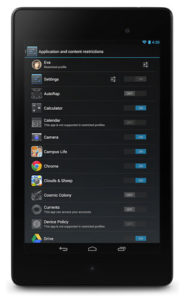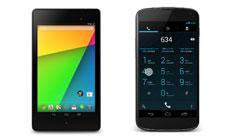Google’s announced a new streaming content device (Chromecast), a new Nexus tablet and an update to Android Jelly Bean (version 4.3). Jelly Bean 4.3 contains many goodies for gaming, access control and even connected health devices – all just a few months after
Android 4.2 was announced at
Google I/O 2013. Updates in 4.3 reflect Google's ongoing commitment to building a flexible operating system that fits in well at home, school and the enterprise. I find the following four updates the most compelling.
Games Go Big

Casual cross-platform titles are the future of mobile gaming. Google is actively updating its platform and marketplace to
support this new era. The latest iteration of Jelly Bean includes plenty of features to support high definition gaming, such as more efficient CPU usage and smoother textures and shapes. Native and Web-based apps will benefit from this boost in rendering speed. Google Chrome updates were featured at I/O 2013. Demos included detailed 3D graphics rendering from the browser and a
multi-device racing game. Android 4.3 improvements are poised to help grow the new cross-platform gaming business Google wants developers to build.
Bluetooth Connectivity for Health
The new
Bluetooth Low Energy API lets you connect your Android app to a range of devices. If you haven't lived under a rock for the last few years, you already know there's a growing market for connected health monitoring devices. The Bluetooth Low Energy specification allows devices to connect and transmit data from one to another. Useful healthcare applications include body temperature measurement, heart rate monitoring, immediate service alert, time and proximity, and glucose monitoring. Your Android app can send or receive alerts to or from a Bluetooth device that go beyond the concept of a smartwatch. Bluetooth is backing Android integration. They're even working on an
Android Application Accelerator tool kit to shorten development time for Bluetooth-enabled apps.
Restricted Profiles Open Possibilities
Last year, Amazon introduced the Kindle Fire HD with a new profile manager called
FreeTime, which allowed families to share a single tablet. Among other things, parents can control content and time their kids spend on the device. Android 4.3 includes similar support for multiple users called
Restricted Profiles. Just as the name implies, multiple users can be allowed either full or restricted access to device content. Access can be allowed based on a number of rules (or restrictions) set by the device’s owner. This addition, along with
Google Play for Education, makes an excellent pairing for school use. Google Play for Education allows schools to curate private marketplaces and purchase apps in bulk for multiple devices. New app restrictions aren’t automatically implemented from the Google Play Store: Developers must declare support and add options to their apps. See the
Android 4.3 API reference for detailed implementation examples and caveats.
DRM to Drum Up Content
Don't roll your eyes just yet. The new modular DRM framework and VP8 encoder support mean more streaming content will be available on Android devices in the future. It's the sort of update major media players like to see for personal devices, since it means content can be better protected and streamed on any compatible machine.
Enterprise and Security Selling Points
Android ranked last in Enterprise security, according to a 2012 study sponsored by TrendMicro. It’s just one reason the OS has struggled to make inroads into the Enterprise. Perception of insecurity as much as actual reported vulnerabilities hinder its adoption. Android 4.3 uses
SELinux sandboxing to better protect the system from potential threats. Additional enhancements include secure KeyChain and Keystore functions. Private keys can’t be exported from a device, or seen or used by another app.
The July 29th episode of
This Week in Android Development gives a quick rundown of these features, and provides code examples for implementation. Tune in for a fast-paced video introduction to Android 4.3, and read
the full Android 4.3 API overview to see what else is new.
 Casual cross-platform titles are the future of mobile gaming. Google is actively updating its platform and marketplace to support this new era. The latest iteration of Jelly Bean includes plenty of features to support high definition gaming, such as more efficient CPU usage and smoother textures and shapes. Native and Web-based apps will benefit from this boost in rendering speed. Google Chrome updates were featured at I/O 2013. Demos included detailed 3D graphics rendering from the browser and a multi-device racing game. Android 4.3 improvements are poised to help grow the new cross-platform gaming business Google wants developers to build.
Casual cross-platform titles are the future of mobile gaming. Google is actively updating its platform and marketplace to support this new era. The latest iteration of Jelly Bean includes plenty of features to support high definition gaming, such as more efficient CPU usage and smoother textures and shapes. Native and Web-based apps will benefit from this boost in rendering speed. Google Chrome updates were featured at I/O 2013. Demos included detailed 3D graphics rendering from the browser and a multi-device racing game. Android 4.3 improvements are poised to help grow the new cross-platform gaming business Google wants developers to build.



